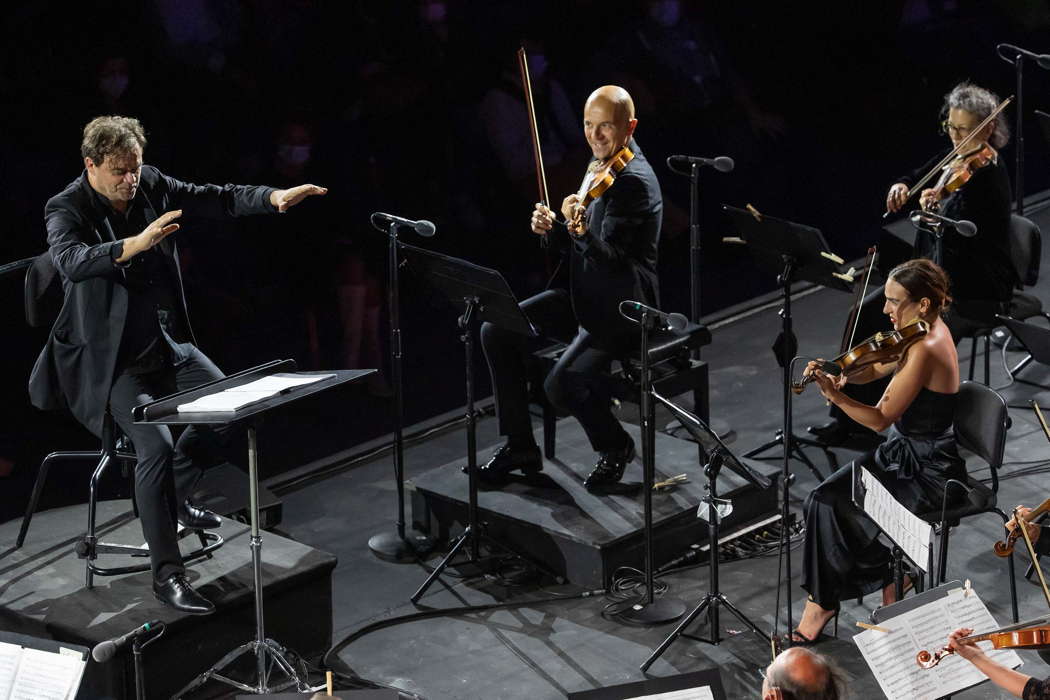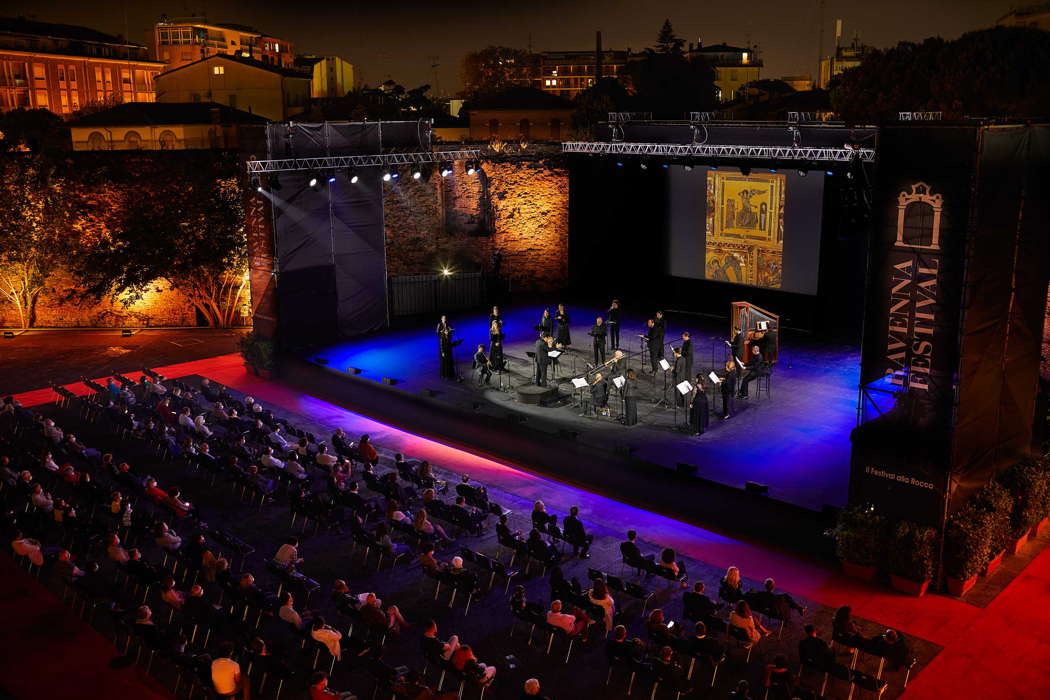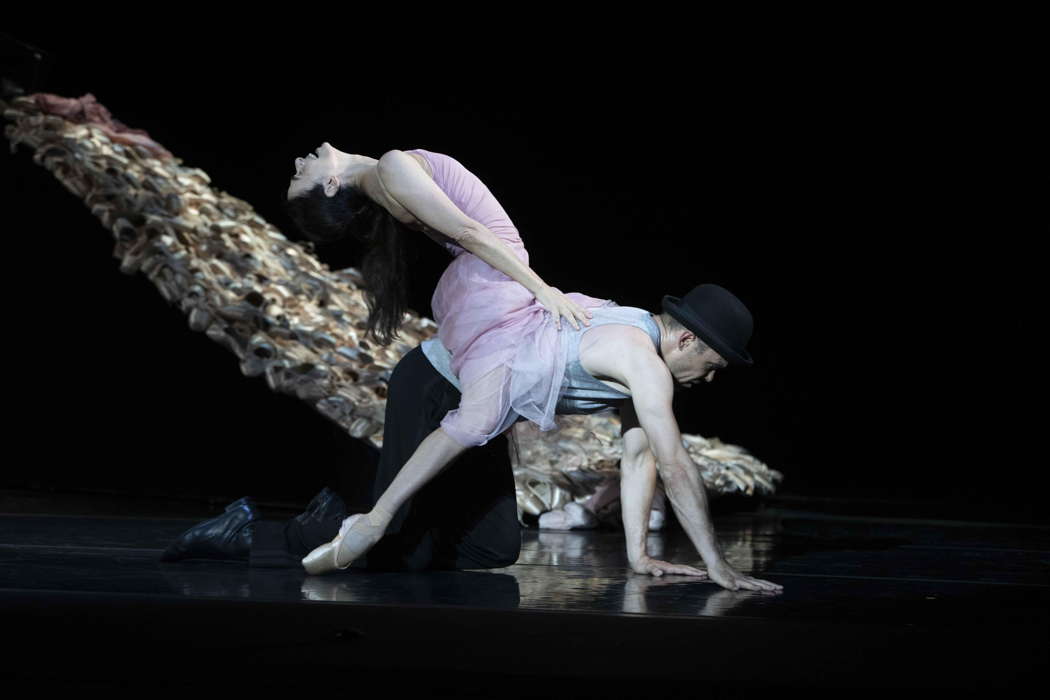 SPONSORED: An Outstanding Evening - Bill Newman listens to American pianist Rorianne Schrade.
SPONSORED: An Outstanding Evening - Bill Newman listens to American pianist Rorianne Schrade.
All sponsored features >>
Three Days in Ravenna
GIUSEPPE PENNISI samples Northern Italy's high profile and wide-ranging arts festival
The Ravenna Festival has always been a multidisciplinary event. Like the Salzburg Summer Festival, it presents mainly music - concerts and musical theatre, with a special autumn session reserved for opera - but also drama and ballet. It is undoubtedly to be commended that this summer, despite the uncertainties and restrictions due to the pandemic, the organizers were able to set up a program with over sixty productions from 2 June to 31 July in mainly outdoor venues in Ravenna and its surroundings. There is a rich and fascinating program, like at the Salzburg Summer Festival or at the Enescu Festival in Bucharest, allowing those who went to the Festival for less than three days - actually two and a half days - to attend five performances.
In order of time, the first performance I attended was a symphonic concert by the Accademia Bizantina led by Ottavio Dantone. The group is known mainly for its philological performances, with period instruments, of seventeenth-century, eighteenth-century and early nineteenth-century music. Performances such as those of Vivaldi's L'Olimpiade, Monteverdi's Il ritorno di Ulisse in patria, and Handel's Rinaldo and Il trionfo del tempo e del disinganno marked a turning point in performance practice and remained memorable.
I do not know if this is the first time that this orchestra and conductor face the Romantic repertoire, and in particular German symphonic romanticism. It is, however, a novelty that has attracted not only many Italians but also numerous foreigners to Rocca Brancaleone, the concert venue, especially from the Germanic world. Although there was fear of a thunderstorm, the Rocca's outdoor auditorium was packed. The acoustics are good thanks to the thick, high walls built by the Venetians at the end of the fifteenth century.

Accademia Bizantina playing at Rocca Brancaleone in Ravenna on 5 June as part of the 2021 Ravenna Festival. Photo © 2021 Zani Casadio
The two symphonies are short and can be performed without interval in order to comply with the anti-COVID-19 rules. They are very well known. What is most interesting is the reading by Dantone and the orchestra. The two symphonies have titles that indicate two precise locations: Italy and the Rhine. Mendelssohn composed the fourth symphony after a long journey to Europe in which he had received a strong impression of Italy. Schumann composed the third symphony in Düsseldorf, a city that is crossed by the Rhine. Dantone and the orchestra read the two scores in an almost pictorial way.
The four movements of Mendelssohn's fourth symphony became four paintings in music at the end of the 'Grand Tour', then in use in the German upper bourgeoisie and aristocracy, especially if intellectual. These are images of the immediacy and of the sunshine of the country 'where lemons arise' (as Dantone himself said in an interview). In the lively and joyful first movement, Dantone and the orchestra enhance the rhythm and writing in sonata form. The second is the re-enactment (in D minor) of a funeral procession followed by the composer in Naples; there is nothing lugubrious but a sense of melancholy, especially in the melodic abandonments of the strings. In the third movement, the typical and classic minuet acquires a Latin colour. In the fourth movement, the saltarello and the tarantella evoke Italian joy as heard, seen and painted by a German. Dantone conducted in a tight manner, with intensity and, at the same time, with joy.
The Rhenish can be considered the last symphony of Robert Schumann, still young but already struggling with the mental illness that, after a few years, took him to an asylum. It is an experimental work in five movements instead of the canonical four. Dantone starts with a strong catch in the Vivace, and then slows down in the Scherzo and Non presto; he shows all the solemnity of the fourth movement and emphasizes the still vivace finale. It is a painting, but not a 'Grand Tour' picture. Rather, an almost pre-Impressionistic painting of Germany's symbolic river, the Rhine, seen with a tormented introspection. The orchestra followed Dantone very well in these two readings, and all were of a high standard, especially brass and horns.

Ottavio Dantone conducting Accademia Bizantina at Rocca Brancaleone in Ravenna on 5 June as part of the 2021 Ravenna Festival. Photo © 2021 Zani Casadio
As part of the Festival, the program In Templo Domini is performed on Sunday mornings: Ravenna's guest ensembles accompany one of the most important Masses. Cappella Marciana, established at the beginning of the seventeenth century (and of which Claudio Monteverdi was one of the directors), accompanied the 6 June 2021 Mass officiated by the Archbishop of Ravenna, Monsignor Grizzoni, on the occasion of the feast of Corpus Domini. A selection of liturgical passages by Andrea Gabrieli was chosen, in fact a relatively little known Mass. Of course, the choir was the great protagonist, a fascinating group whose singing embraced the entire vast Metropolitan Basilica, especially with the soprano voices in a very high register.

Cappella Marciana performing on 7 June at the 2021 Ravenna Festival. Photo © 2021 Zani Casadio
In a music review, a ballet, co-produced with the American AF Dance and the British Royal Ballet (and premiered in Ravenna) deserves to be mentioned as an exceptional event. The short ballet - two parts of an hour and a quarter altogether - is based rather faithfully on Samuel Beckett's play Oh les beaux jours (Happy Days) about the memories of two elders (Winnie and Willy) of the 'exquisite hours' of their youth. It is, in many respects, a revival of a production conceived, in 1998, by Torino Danza for Carla Fracci. It was rearranged for Alessandra Ferri (who had farewelled the scenes a dozen years ago), on the occasion of forty years since her debut. She is the aged dancer who, with her partner Carsten Jung, remembers the 'good days' of their youth. She is not submerged by a hill of sand, as in Beckett's play, but by a mountain of old ballerina shoes. Dance experts can comment better than me on a show that seemed fascinating and moving. The taped soundtrack opens and closes with 'Lippen schweigen' from Lehár's Die lustige witwe. Mahler's pieces predominate; there are the echos of a Mozart piano concerto and Webern peeps in at the most dramatic moments.

Alessandra Ferri and Carsten Jung in the ballet L'Heure Exquise at the 2021 Ravenna Festival. Photo © 2021 Silvia Lelli
On the seven hundredth anniversary of Dante's death (in Ravenna), the memory of the supreme poet is the thread that connects most of the Festival's events, although, due to the pandemic, the most complex production, such as to involve part of the city's population, has been postponed to 2022. The Dante e I Trovatori concert is important for three reasons: a) it was held on 7 June 2021 in the church of San Francesco where Dante was given the last farewell; b) troubadours play a role in Dante's poetics especially in the Purgatory of the Divine Comedy; c) it is rare to listen to a concert centered on the songs of the troubadours. A comprehensive study on the subject is that by Marcello Schembri: I Trovatori, Musica e Poesia (Zecchini Edition, 2018). I remember only a concert of ancient music especially at making known the troubadours: in 2016, in the Court of Honor of Castelbellino as part of the Festival Pergolesi Spontini. The Micrologus Ensemble of Assisi performed that concert - read 'A Very Rich Menu', Music & Vision Magazine, 8 September 2016. It was music, in many respects, different from that heard in Ravenna. The troubadours of Micrologus were in the wake of crusades and, therefore, their singing had a warrior accent. The troubadours chosen by Enea Sorini and Beppe Frana, on the other hand, are those Dante encounters in the XXVI Canto del Purgatorio, in the group of lustfuls. They are, to a large extent, Provençal and their songs yearn for profane love, with slightly concealed erotic content. Enea Sorini has a high, velvety register and plays the psaltery. Beppe Frana plays the oud (which is also called the 'Saracen guitar'). They performed songs of seven troubadours. There is an eastern influence in this music that travelled from Seville and Córdoba to Provence and from there to Florence and perhaps also to Ravenna itself. It is to be hoped that the concert will become the basis of a CD.

Enea Sorini (left) and Beppe Frana performing in the 'Dante and the Troubadours' concert in the Basilica di San Francesco at the 2021 Ravenna Festival. Photo © 2021 Luca Concas
There is a link between the troubadours, particularly those following the Crusades and the Pala d'Oro (Golden Altarpiece) of St Mark that dominates the Basilica of Venice. History, or rather legend, states that the most beautiful precious stones of the East - sapphires, emeralds, rubies, pearls and amethysts - arrived in Venice as spoils of the Fourth Crusade (1204). It took a couple of centuries to frame them in a Golden Altarpiece whose 'tiles' depict scenes from the Old and New Testaments. Marco Gemmani, the director of Cappella Marciana, selected music from the Venetian polyphonic school to give a musical explanation, and at the same time a commentary, to each of the tiles. The composers heard in the concert are Claudio Merulo, Ludovico Balbi, Balassarre Donato, Andrea Gabrieli, Giulio Belli, Claudio Monteverdi, Giovanni Gabrieli, Giovanni Croce, Gioseffo Zarlino and Giovani Bassano. The choir is accompanied by an organ (Nicola Lamon), a cornetto (Andrea Inghisciano) and three trombones (Ermes Giussani, Mauro Morini and Fabio Costa). This was a gaunt and essential accompaniment because all the magic is in the voices - six sopranos, four altos, four tenors and four basses - which illustrate 'the tiles' and their meaning, while on a maxi-screen the images of the Golden Altarpiece flow. This was great music from great composers, performed perfectly for a great production.
Copyright © 10 June 2021
Giuseppe Pennisi,
Rome, Italy




